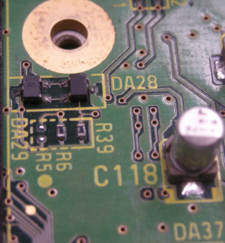Region Switch: Difference between revisions
Megalomaniac (talk | contribs) No edit summary |
Megalomaniac (talk | contribs) No edit summary |
||
| Line 1: | Line 1: | ||
A Region Switch is a hardware modification | A Region Switch is a hardware modification for the Gamecube to bypass regional lockout protection and change native language support on Gamecube hardware versions NTSC-U (USA) and NTSC-J (JAPAN). | ||
The IPL [[WikiScene:GameCube#GameCube_Original_BIOS_.28IPL.29_Version_Information|(Gamecube "BIOS"]]) of these two Gamecube versions offer support for both English and Japanese languages, but not at the same time. A Region Switch can be enabled or disabled to allow support for [[Playing_Imports|playing import]] USA or Japanese original Gamecube titles, respectively. | |||
<small>Note: Backup discs require use of a [[:Category:Modchips|modchip]].</small> | |||
== Memory Card Compatibility == | |||
The Gamecube's Memory Card data format is determined by the console region. While NTSC-U and PAL save data can typically be stored on the same memory card, memory cards used with NTSC-J consoles must be reformatted to Japanese settings or data corruption can occur. A separate memory card should be used for each region to avoid data corruption and/or loss of save data. | |||
== NTSC-J Hardware == | |||
[[File:Region NTSC-J.png|thumb|225px|alt=NTSC-J|'''NTSC-J''' motherboard shown with<br> '''no resistor at R6''']] | |||
To allow an NTSC-J(Japanese) Gamecube compatibility for use with NTSC-U (USA) original titles, a modification to resistor location "R6" is required. <br> <br> | |||
At location R6, two solder points can be seen where the resistor was not installed during production. By closing the circuit's path (shorting the two points), the Gamecube region will be changed. <br><br> | |||
These two points can be soldered together for a permanent region change or an on/off switch can be installed to allow region interchangeability. If using a switch, the switch should be set to the desired regional position prior to system power up. <br><br><br><br><br><br> | |||
== NTSC-U Hardware == | |||
[[File:Region NTSC-U.png|thumb|225px|alt=NTSC-U|'''NTSC-U''' motherboard shown with<br> '''no resistor at R5''']] | |||
<small>Same steps for hardware modification as described above.</small><br> | |||
To allow an NTSC-U (USA) Gamecube compatibility for use with NTSC-J(Japanese) original titles, a modification to resistor location "R5" is required. <br> <br> | |||
[[Category:Howto]] | [[Category:Howto]] | ||
Revision as of 16:46, 16 January 2013
A Region Switch is a hardware modification for the Gamecube to bypass regional lockout protection and change native language support on Gamecube hardware versions NTSC-U (USA) and NTSC-J (JAPAN).
The IPL (Gamecube "BIOS") of these two Gamecube versions offer support for both English and Japanese languages, but not at the same time. A Region Switch can be enabled or disabled to allow support for playing import USA or Japanese original Gamecube titles, respectively.
Note: Backup discs require use of a modchip.
Memory Card Compatibility
The Gamecube's Memory Card data format is determined by the console region. While NTSC-U and PAL save data can typically be stored on the same memory card, memory cards used with NTSC-J consoles must be reformatted to Japanese settings or data corruption can occur. A separate memory card should be used for each region to avoid data corruption and/or loss of save data.
NTSC-J Hardware

no resistor at R6
To allow an NTSC-J(Japanese) Gamecube compatibility for use with NTSC-U (USA) original titles, a modification to resistor location "R6" is required.
At location R6, two solder points can be seen where the resistor was not installed during production. By closing the circuit's path (shorting the two points), the Gamecube region will be changed.
These two points can be soldered together for a permanent region change or an on/off switch can be installed to allow region interchangeability. If using a switch, the switch should be set to the desired regional position prior to system power up.
NTSC-U Hardware

no resistor at R5
Same steps for hardware modification as described above.
To allow an NTSC-U (USA) Gamecube compatibility for use with NTSC-J(Japanese) original titles, a modification to resistor location "R5" is required.